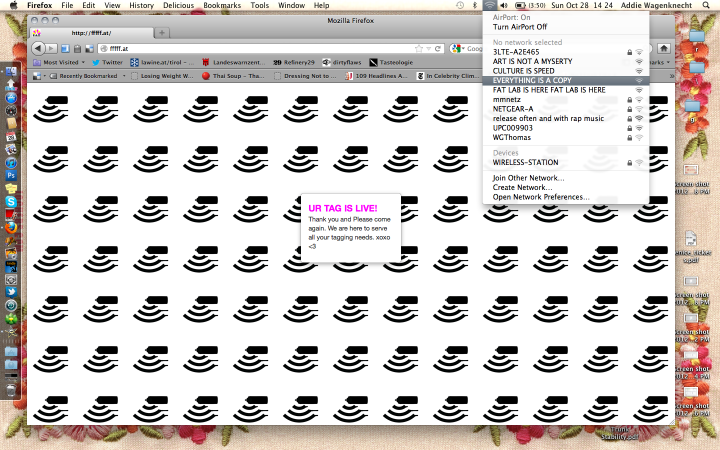A collaboration between Addie Wagenknecht & Pablo Garcia
“I know it when I see it.” – US Supreme Court Justice Potter Stewart, on the elusive definition of hardcore pornography, 1964.
If asked if there is a difference between the Renaissance painting The Birth of Venus (1486) and a Playboy centerfold, most might say it’s no contest: one is art and the other pornography. One is of human ideals, the other smut. Are Botticelli and Hugh Hefner really that different? Both project fantasy and erotic imagery through the media of their day. Both are vehicles of gender politics, defining standards of beauty and sexuality. What if adult performers—already mediated sex objects—struck “classic†poses?
In Webcam Venus, we asked online sexcam performers to replicate iconic works of art. This piece is an experimental homage to both fine art and the lowbrow internet phenomenon of cams. Sexcams use webcams and chat interfaces to connect amateur adult performers with an audience. Users log on to see men, women, transsexuals, couples and groups broadcast their bodies and sexuality live for the public, often performing for money. To create this experiment in high and low brow media, we assumed anonymous handles and spent a few hours each day for a month asking performers: “Would you like to pose for me?† Â
BEAUTY
What is beauty today? By operating in the language of sexcams, we alter the contemporary ideal of beauty with the ubiquitous display of sexuality online. We challenge the institutions which enforce false perceptions of propriety—via nudity in classical painting—as the only form of acceptable safe-for-work beauty. Publicly presented traditional paintings and sculptures are prevalent with sexuality and gender politics, and yet the display of nudity online is usually defined as ‘pornography’. Amateur adult broadcasters also resist the popular, contemporary definition of beauty. They are not the typical definition of beauty prevalent main stream media: heavily Photoshopped image in the name of advertising, which destroys self image and confidence while encouraging materialism. Sexcam performers are the apotheosis of the most honest parts of us and yet typically the least valued part of a society. Even though they are transmitted virtually, they are real people and they are beautiful.
![fantasiexxx as La Vague (The Wave), William-Adolphe Bouguereau (1896) [Click image for NSFW version]](https://fffff.at/files/2013/03/fantasiexxx-as-Bourgoureau-Wave-censor-1024x363.jpg)
fantasiexxx as La Vague (The Wave), William-Adolphe Bouguereau (1896) [Click image for NSFW version]
PUBLIC INTIMACY
By researching interactive online spaces, we were drawn to those where intimacy goes public—social media, blogs, webcams, chat rooms—and the idea they the content is accessible worldwide. The division between “in real life” (IRL) and “not in real life” (NIRL) is dissolving. Our relationships and most intimate interactions are no longer happening in the same room or even same language. With social media, developing a presence on the internet has become as simple as logging in. Opening your personal world to the outside world frames us each as our own brand—we maintain Twitter feeds, Facebook pages, promote our families, ourselves, we Foursquare every place we go to and Instagram everything we eat. We are becoming a society where we create, produce, and consume all at the same time. In this paradigm of public intimacy, cybersex and sexcams not only seem less deviant, they practically seem inevitable.
Webcam Venus is also about networked cultures and digiphrenia: how technology lets us be in more than one space—or even more than one identity—at the same time. Sexcam performers craft identities through provocative handles, costumes, masks, and interior decoration for the viewing audience. Their display of sexuality is part of this identity. When asked to pose in a “classic” manner, sexcam performers become suddenly self-aware; they want to adjust their hair or surroundings to meet the request. For an instant, Webcam Venus reveals the identity that lives just outside the cam space; one where the person must improvise beyond the established protocols of adult performance. We began to see a paradox emerge: IRL (in real life), art nudes are acceptable while naked bodies are inappropriate; NIRL (not in real life), graphic sex acts are acceptable yet de-sexualization on cam was difficult for some performers to maintain.

frogmann as Arrangement in Grey and Black No.1 (Whistler’s Mother), James McNeill Whistler (1871)
PROCESS
Before we even began this project, we used email, chat, and VoIP to build our collaborative efforts. The downside, however, was that it limited the types of projects we could attempt. This was our design constraint. We began looking at those tools of collaboration; the same tools to communicate and what those tools say about all of us. We talked to each other through our instant technology. We watched how certain private moments became available to each other; our 7-hour time difference meant mornings met afternoons, nights shared space with early mornings. Personal life, our domestic interiors, all became part of our interactions. We then wondered: “Wait. Where have we seen this before?â€

Typical SexCam environment: live cam and chat scroll. All poses were executed through this interface. Models take direction to help strike the pose; other guests frequently chime in to request their desire.
The models are live, and we propose via text chat scroll: “Would you like to pose for me?” or similar. We—like all guests in the cam rooms—only type in limited but sequential lines of text in a chat scroll. The performer can either interact via typing text lines which appear in the chat scroll along with our comments, or speak directly to guests in audible voice. The majority of performers do not speak, even though many have a microphone broadcasting ambient sound like background music. If they respond at all—a lot of hours spent being ignored—we start discussing the pose. We show them an image, either through asking them to do a Google search, or a URL we paste in the chat line. Sometimes we make our avatar profile pic the pose we want so they can click on it directly. They pose, holding for 30-60 seconds. They take direction from us to “correct” their pose. The webcam became the image frame. The performer’s bedrooms or kitchens or bathrooms became the backdrop to these new works and mash-up of histories.
CREDITS AND CONTACTS
Webcam Venus was conceived and developed for FAT lab by Addie Wagenknecht and Pablo Garcia. Webcam Venus is a work in two parts and will be shown in its entirety at FAT GOLD April 1-13 2013 at Eyebeam NYC. (HINT: Don’t miss this kids. All of FAT will be there…!) For inquiries about Webcam Venus, please email us or tweet (@wheresaddie // @prgarc )  Webcam Venus
Webcam Venus
GET ROUTER, HACKÂ = WIFI TAGGING
The Basics:
1) Get a TP-Link WR741ND router (around $10-20)
2) Download the wifitagger firmware
3) follow the README
4) drop modem in public
5) connect to “Free Public WifiTagger”, instant unlimited tagging of networks within range, 100% satisfaction guaranteed!!
WifiTagger is a router which is enabled to tag wifi networks. Upon selecting “Free Public WifiTagger” as your network, you can tag the wifi spectrum via the WifiTaggers open UI. It can broadcast a tag up to four lines of 32 characters. Tags will be viewable within the list of wifi networks. It allows anyone with a wifi enabled device the ability to tag digital space.
Too lazy to make one? You can check out FATS’s very own WifiTaggers tagging all over Chelsea as of November 5th and at FAT GOLD.
The expressions published in this site are all in the public domain. You may enjoy, use, modify, snipe about and republish all F.A.T. media and technologies as you see fit.








![boobz_4_play as Reclining Nude, Amadeo Modigliani (1917) [Click image for NSFW version]](https://fffff.at/files/2013/03/boobs4play-as-Modigliani-1024x344.jpg)



![wowiewowie as Mademoiselle Rose, Eugène Delacroix (1817-24) [Click image for NSFW version]](https://fffff.at/files/2013/03/wowiewowie-as-Delacroix-Mdme-Rose-1024x515.jpg)




